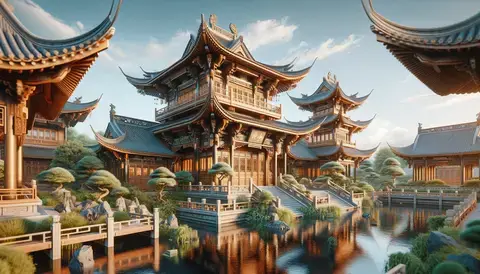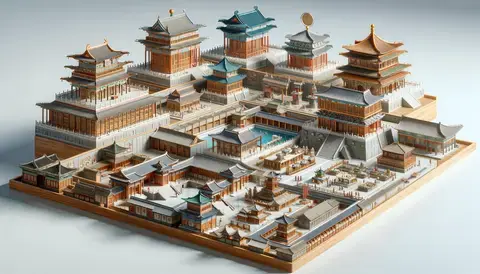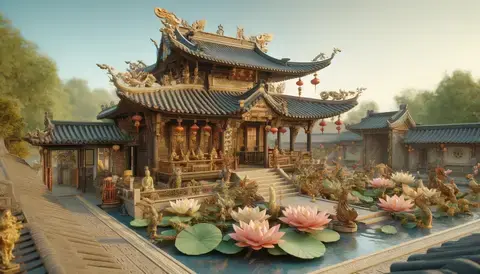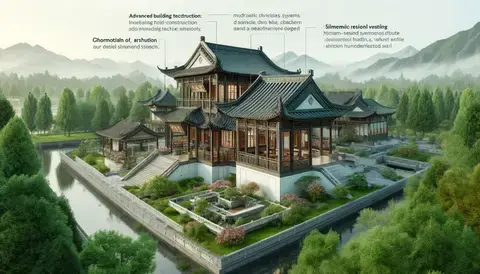Exploring the Architectural Wonders of China | Ancient Chinese Architecture

2024 Free Course Guide:
Ever wondered how a nation's history shapes its skyline? China's architectural landscape offers a stunning reflection of its rich cultural tapestry, artistic excellence, and ingenious engineering. This article embarks on a fascinating exploration of Chinese architecture, tracing its evolution from ancient marvels to contemporary wonders. Join us as we delve deep into the historical significance and enduring legacy of Chinese buildings that have not only shaped the physical contours of this great nation but have also left an indelible mark on the world.
Ancient Chinese Architecture: Discovering the Foundations of Time-Honored Designs
The wonders of Ancient Chinese Architecture: This course takes you through the architectural marvels from ancient China, highlighting how these designs have influenced both historical and modern landscapes. Simple explanations and engaging content will help you appreciate the ingenuity of ancient architects.
Introduction to Ancient Chinese Architecture
Overview: Defining Ancient Chinese Architecture
Ancient Chinese architecture is a broad term that encompasses various structural and decorative styles developed across centuries in China. This architectural tradition is characterized by wooden structures with large, sweeping roofs that often feature intricate details and upturned edges. The use of timber frames, tiled roofs, and a strong emphasis on symmetry and alignment with the spiritual principles of Feng Shui are also hallmark features. This architecture not only served practical purposes but also reflected the social hierarchy and religious beliefs of the time.
Course Goals
By the end of this module, you will:
- Identify Key Architectural Features: Learn to recognize the structural elements that define ancient Chinese buildings, such as roof styles, wooden brackets, and layout configurations.
- Understand Cultural Significance: Gain insights into how architecture was influenced by Confucianism, Taoism, and Buddhism, shaping the social and spiritual landscape of ancient China.
- Appreciate Architectural Evolution: Observe how ancient Chinese architecture evolved through different dynasties, adapting to changing times while maintaining its core principles.
Fun Fact
Did you know the Forbidden City contains exactly 9,999 rooms? This number was not chosen at random; it symbolizes longevity and eternality, reflecting the ancient Chinese belief that the number nine is auspicious. The emperor's palace was designed to be a celestial place on earth, mirroring the heavenly palace of the Jade Emperor, which was believed to have 10,000 rooms—just one room more than the emperor's palace to maintain the celestial hierarchy.
Historical Foundations

- Timeline of Chinese Architectural History: A simple timeline from the Xia Dynasty to the Qing Dynasty.
- Influences on Architecture: How traditions and beliefs shaped the buildings in ancient China.
- Materials and Techniques: Discover the basic materials and building methods used in ancient times.
Historical Foundations of Ancient Chinese Architecture
Timeline of Chinese Architectural History
This section provides a straightforward timeline that traces the evolution of architecture from the Xia Dynasty through to the Qing Dynasty. Each period is marked by distinct architectural styles and techniques that reflect the socio-economic and political landscapes of the times.
- Xia Dynasty (c. 2070–1600 BC): Beginnings of Chinese civilization with rudimentary structures.
- Shang Dynasty (c. 1600–1046 BC): Introduction of urban planning and palatial complexes.
- Zhou Dynasty (c. 1046–256 BC): Expansion of city designs and use of wood in construction.
- Qin Dynasty (221–206 BC): Standardization of construction methods across the empire.
- Han Dynasty (206 BC–220 AD): Flourishing of the imperial architecture and the Silk Road influences.
- Six Dynasties Period (220–589 AD): Innovations in Buddhist architecture and pagoda construction.
- Sui and Tang Dynasties (581–907 AD): Golden age of cosmopolitan influence and grand Buddhist temples.
- Song Dynasty (960–1279 AD): Developments in garden design and residential architecture.
- Yuan Dynasty (1271–1368 AD): Integration of Islamic architectural elements.
- Ming Dynasty (1368–1644 AD): Renaissance of traditional Han Chinese architecture and major constructions like the Forbidden City.
- Qing Dynasty (1644–1912 AD): Last imperial dynasty known for elaborate gardens and expansive palaces.
Influences on Architecture
Ancient Chinese architecture was profoundly influenced by the country’s rich traditions and philosophical beliefs, particularly Confucianism, Taoism, and Buddhism. These influences are evident in the emphasis on harmony, symmetry, and hierarchical layouts in architectural designs.
- Confucianism: Promoted structures that reflected social hierarchy and order.
- Taoism: Inspired designs that harmonized with the natural world, leading to the integration of landscapes and water features in architectural layouts.
- Buddhism: Introduced the stupa design, which evolved into the distinctive multi-tiered pagodas, as a significant element in religious and funerary buildings.
Materials and Techniques
The primary materials used in ancient Chinese architecture included wood, stone, bricks, and tiles. Wood was predominant due to its availability and ease of use, which influenced the development of unique structural techniques.
- Wooden Frameworks: The use of wooden post-and-lintel systems allowed for flexible yet durable structures that could withstand frequent earthquakes.
- Dou Gong Brackets: These are sets of interlocking wooden brackets that are one of the most important elements in traditional Chinese architecture. They are used to support the overhanging roofs and increase the structure’s strength.
- Tile Roofing: Introduced during the Han Dynasty, roof tiling became an art form with elaborate decorative motifs and an array of colors that signified the building’s function and importance.
This section sets the stage for a deeper exploration of specific architectural achievements in subsequent modules, enriching students' understanding of how ancient practices and innovations laid the foundation for modern Chinese architecture.
Defining Features of Ancient Chinese Architecture

- Roof Structures and Their Significance: Explore the styles of roofs and what they symbolize.
- Feng Shui in Architecture: How ancient builders used Feng Shui to decide the location and design of buildings.
- Symbolism in Decorations: Learn about the meanings behind common architectural decorations.
Features of Ancient Chinese Architecture
Roof Structures and Their Significance
In ancient Chinese architecture, the roof is not just a cover; it's a canvas of cultural expression. Various roof styles, such as the sweeping curved roofs found in palatial buildings and temples, serve both practical and symbolic purposes. These roofs are often adorned with intricate decorations such as animal figures, which are believed to ward off evil spirits and bring good luck. The curvature of the roof also symbolizes the connection between heaven and the human world, fostering a sense of harmony and balance.
Feng Shui in Architecture
Feng Shui, an ancient Chinese practice of arranging the environment to enhance harmony and balance, plays a critical role in architectural planning. The orientation, structure, and materials of a building are meticulously chosen to align with Feng Shui principles, aiming to promote positive energy flow (Chi) and prosperity. Key considerations include the direction the building faces, the arrangement of spaces, and the interaction with natural elements like water and mountains.
Symbolism in Decorations
Decorative elements in ancient Chinese architecture are rich with symbolic meaning, often reflecting philosophical, religious, and social values. From dragon motifs symbolizing power and strength to lotus flowers representing purity and enlightenment, each decorative detail carries deeper significance. These elements are not only aesthetically pleasing but also serve as cultural narratives that communicate the beliefs and aspirations of the people.
Key Architectural Sites and Their Histories
- The Great Wall of China: Understand why and how this massive structure was built.
- The Forbidden City: Discover the design and purpose of this imperial palace.
- Famous Temples: A look at important religious sites and their architectural styles.
The Great Wall of China: A Monument to Defense and Endurance
The Great Wall of China is not just a wall but a series of fortifications made of stone, brick, tamped earth, wood, and other materials, generally built along an east-to-west line across the historical northern borders of China. It was primarily constructed to protect the Chinese states and empires against the raids and invasions of the various nomadic groups from the Eurasian Steppe. Construction of the wall started as early as the 7th century BC, with several enhancements and reinforcements added by subsequent dynasties. The most well-known sections of the wall were built during the Ming Dynasty (1368–1644 AD). Beyond its defensive function, the Great Wall also served as a means of controlling immigration and emigration, and facilitated the imposition of duties on goods transported along the Silk Road, becoming a symbol of the enduring strength and resilience of the Chinese civilization.
The Forbidden City: Seat of Imperial Power
The Forbidden City, located in the heart of Beijing, served as the imperial palace from the Ming dynasty to the end of the Qing dynasty (1420 to 1912). It is called 'Forbidden' because no one could enter or leave the palace without the emperor's permission. Architecturally, it is a masterpiece, and it showcases the traditional Chinese palatial architecture. The complex consists of 980 buildings covering 180 acres, surrounded by a 26-foot high wall and a 171-foot wide moat. Each architectural detail—from the layout to the smallest design elements—was meticulously planned to reflect philosophical and religious principles, symbolizing the majesty of Imperial authority and the centrality of the emperor in the universe.
Famous Temples: Spiritual and Architectural Splendors
Chinese temples are renowned for their striking beauty and intricate craftsmanship, which reflect the deep spiritual and philosophical underpinnings of Chinese culture. Some notable examples include:
- The Temple of Heaven in Beijing: An imperial complex of religious buildings symbolizing the relationship between earth and heaven—the human world and God's world—which was central to the cosmology of ancient China. It was here that the emperor would perform rites and make sacrifices to Heaven for good harvests.
- The Shaolin Temple: Located in Henan province, this Buddhist temple is not only a major religious site but also the birthplace of Shaolin Kung Fu. It showcases unique architectural styles that have influenced not only religious buildings but also martial arts.
- The Hanging Temple: An architectural wonder built into a cliff near Mount Heng in Shanxi Province. This temple represents a rare combination of three traditional Chinese religions: Buddhism, Taoism, and Confucianism.
Each of these sites provides a unique insight into the architectural styles, religious practices, and cultural values of their times. They not only serve as places of worship but also as custodians of history, showcasing the architectural innovations and the spiritual ethos of ancient China.
Architectural Innovations and Techniques

- Advanced Building Techniques: Simple explanations of how ancient builders overcame engineering challenges.
- Integration with Nature: How architects designed buildings to blend with the surrounding environment.
Advanced Building Techniques
Ancient Chinese architects were pioneers in developing sophisticated construction techniques that addressed both the aesthetic aspirations and practical needs of their time.
- Modular Construction: One of the hallmarks of ancient Chinese architecture is the use of standardized prefabricated components. This modularity not only facilitated the swift assembly and repair of structures but also ensured consistency and stability across vast architectural projects.
- Bracket Systems (Dou Gong): A unique structural element of traditional Chinese architecture, these interlocking wooden brackets were used to support extended roof eaves without the need for exterior walls or additional support. This technique distributed weight evenly, allowing for more open spaces within buildings and greater flexibility in layout.
- Seismic Resistance: Given China's seismic activity, builders invented flexible structures capable of withstanding earthquakes. Techniques included the use of loose-fitting giant wooden frames that could flex during tremors, reducing the likelihood of collapse.
Integration with Nature
Reflecting the Taoist and Buddhist belief systems emphasizing harmony with nature, ancient Chinese architecture often melded seamlessly with its surroundings, enhancing the inherent beauty of the landscape without overpowering it.
- Site Selection: The choice of location was influenced by geomantic principles (Feng Shui). Architects selected sites that faced south to capture sunlight and protect buildings from northern winds, optimizing for both warmth and light.
- Garden Integration: Unlike Western architecture, where buildings might dominate their landscapes, Chinese architects designed gardens to be integral parts of the overall architectural plan. Gardens, rocks, water features, and the buildings themselves were arranged to replicate and emphasize natural beauty, creating a miniature universe within the garden walls.
- Natural Materials: Materials were chosen not just for durability and practicality but also for their natural aesthetics. Wood, bamboo, stone, and clay were commonly used, materials that could be sourced locally and would age beautifully, blending into the landscape over time.
These techniques and approaches not only solved practical problems but also reflected a profound philosophical commitment to living in balance with the world—a principle that continues to influence modern architecture worldwide.
Impact and Legacy
- Influence on Modern Architecture: See how ancient designs influence today’s buildings.
- Preservation Efforts: Learn about the challenges and solutions in preserving these ancient sites.
Influence on Modern Architecture
Ancient Chinese architectural principles have left an indelible mark on modern architecture, both within China and globally. The integration of traditional aesthetic elements and philosophical concepts into contemporary designs has led to a unique fusion of old and new.
- Aesthetic Influence: The distinctive curved roofs, intricate lattice work, and ornate wooden carvings that characterized ancient Chinese buildings are often incorporated into modern designs to add visual interest and cultural depth.
- Spatial Organization: The ancient practice of organizing space to create a flow of energy (Chi) continues to influence modern architectural layouts. This is evident in the use of open spaces, garden integrations, and orientation that maximizes natural light and air circulation.
- Sustainability: Ancient methods of using local materials and aligning with the natural environment have inspired the modern sustainable architecture movement. Today, these principles are applied using advanced technologies to create energy-efficient and environmentally friendly buildings.
Preservation Efforts
Preserving ancient Chinese architectural sites has become a crucial aspect of cultural heritage management. These efforts face numerous challenges but also benefit from innovative solutions.
- Environmental Challenges: Many ancient structures are vulnerable to natural decay and the impacts of climate change, such as increased humidity, which can deteriorate wooden components.
- Urbanization Pressures: As cities expand, ancient sites often face threats from development pressures. Balancing modernization with preservation requires careful planning and regulation.
- Technological Solutions: Advanced technologies, including 3D scanning and digital modeling, are used to document and monitor the conditions of ancient structures. These tools help in the restoration processes and in creating digital archives for future generations.
- Community Involvement: Increasingly, preservation efforts also focus on involving local communities to ensure that they have a stake in maintaining their cultural heritage. This includes education programs and encouraging local craftsmanship.
The ongoing preservation of ancient Chinese architecture not only protects these physical structures but also ensures the continuation of cultural knowledge and historical legacy. This module highlights how ancient innovations continue to influence modern practices and the global importance of maintaining these historical sites.
Summary and Reflection
Course Review
Throughout this course, we've traversed the vast landscape of Ancient Chinese Architecture, exploring its deep roots and wide-reaching branches. We began by understanding the fundamental structures and materials that defined this architectural style and moved through the dynastic eras that each contributed uniquely to its evolution. From the imposing Great Wall, which stands as a testament to both defense and engineering prowess, to the serene beauty of the Forbidden City and the spiritual grandeur of temple complexes, we've seen how architecture served both practical needs and spiritual aspirations. Key architectural features like roof styles, Feng Shui principles, and symbolic decorations were discussed, emphasizing their importance in cultural expression and practical application.
Further Learning
To deepen your understanding of Ancient Chinese Architecture and explore its nuances further, several resources are recommended:
- Books:
- "Chinese Architecture" by Nancy Shatzman Steinhardt - A comprehensive guide to the historical development and cultural significance of Chinese buildings.
- "The Architecture of Feng Shui" by Nancy SantoPietro - Delves into how Feng Shui has influenced both ancient and modern architectural designs.
- Documentaries:
- "Ancient China's Architectural Wonders" – Available on cultural heritage streaming platforms, this documentary provides visual tours and expert insights into significant Chinese architectural achievements.
- Online Platforms:
- Coursera and Khan Academy offer additional courses and lectures on Chinese art and architecture for those looking to expand their knowledge further.
Final Thoughts
Reflecting on the journey through Ancient Chinese Architecture, it's evident that these ancient principles continue to resonate in modern architectural practices. The balance, harmony, and attention to environmental integration seen in ancient designs provide a blueprint for contemporary architecture around the world. As we move forward, let these timeless principles inspire innovative, sustainable, and culturally resonant designs in our built environments. This course hopefully serves not only as an educational journey but also as an inspiration to incorporate historical wisdom into future creations, fostering spaces that celebrate both heritage and innovation.
Interactive Elements:
- Interactive Timeline: Explore an interactive timeline of Chinese architectural history.
- Quizzes: Test your knowledge at the end of each module.
- Discussion Boards: Share ideas and questions with fellow learners.
This course is designed to be easy to understand, using straightforward language and clear examples. It aims to make learning about ancient Chinese architecture both engaging and informative for everyone.
Explore Further: The Mysteries of Ancient Chinese Architecture
Study ancient Chinese architecture, where centuries-old traditions blend seamlessly with timeless craftsmanship. Discover the architectural marvels of imperial palaces, serene temples, and elegant courtyard residences that have stood the test of time, reflecting the rich cultural heritage and ingenuity of ancient Chinese civilizations. Explore the intricate details, symbolic meanings, and enduring legacies of these architectural treasures as we embark on a journey through the annals of history.
Travel back in time to explore the incredible buildings of ancient civilizations. From the Pyramids of Egypt to the Parthenon in Greece, learn about the amazing structures that people built long ago.
Discover the different kinds of buildings in China, from old temples to modern skyscrapers. Learn about how Chinese architecture has changed over time and what makes it unique.
Explore the many types of buildings you can find in China, like houses, palaces, and temples. See how they're designed and what materials are used to build them.
Find out about the special features you'll see on traditional Chinese buildings, like curved roofs and intricate decorations. Learn what these elements mean and why they're important.
Take a closer look at the decorations on Chinese buildings, like carvings and colorful tiles. Discover how these details make buildings look beautiful and tell stories about Chinese culture.
Visit the peaceful gardens of China, where nature and architecture come together in harmony. Explore the design of these gardens and learn why they're so special to Chinese culture.
Step into the quiet courtyards of Chinese homes and palaces. See how these outdoor spaces are designed for relaxation and family gatherings, and learn about their importance in Chinese life.
